Related Research Articles

Cyberpunk is a subgenre of science fiction in a dystopian futuristic setting that tends to focus on a "combination of lowlife and high tech", featuring futuristic technological and scientific achievements, such as artificial intelligence and cyberware, juxtaposed with societal collapse, dystopia or decay. Much of cyberpunk is rooted in the New Wave science fiction movement of the 1960s and 1970s, when writers like Philip K. Dick, Michael Moorcock, Roger Zelazny, John Brunner, J. G. Ballard, Philip José Farmer and Harlan Ellison examined the impact of drug culture, technology, and the sexual revolution while avoiding the utopian tendencies of earlier science fiction.
Ghost in the Shell is a Japanese cyberpunk media franchise based on the seinen manga series of the same name written and illustrated by Masamune Shirow. The manga, first serialized in 1989 under the subtitle of The Ghost in the Shell, and later published as its own tankōbon volumes by Kodansha, told the story of the fictional counter-cyberterrorist organization Public Security Section 9, led by protagonist Major Motoko Kusanagi, and is set in mid-21st century Japan.

Katsuhiro Otomo is a Japanese manga artist, screenwriter, animator and film director. He is best known as the creator of Akira, in terms of both the original 1982 manga series and the 1988 animated film adaptation. He was decorated a Chevalier of the French Ordre des Arts et des Lettres in 2005, promoted to Officier of the order in 2014, became the fourth manga artist ever inducted into the American Eisner Award Hall of Fame in 2012, and was awarded the Purple Medal of Honor from the Japanese government in 2013. Otomo later received the Winsor McCay Award at the 41st Annie Awards in 2014 and the 2015 Grand Prix de la ville d'Angoulême, the first manga artist to receive the award. Otomo is married to Yoko Otomo. Together they have one child, a son named Shohei Otomo, who is also an artist.
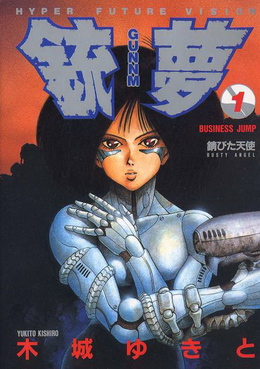
Battle Angel Alita, known in Japan as Gunnm, is a Japanese cyberpunk manga series created by Yukito Kishiro and originally published in Shueisha's Business Jump magazine from 1990 to 1995. The second of the comic's nine volumes was adapted in 1993 into a two-part anime original video animation titled Battle Angel for North American release by ADV Films and the UK and Australian release by Manga Entertainment. Manga Entertainment also dubbed Battle Angel Alita into English. A live-action film adaptation titled Alita: Battle Angel was released on February 14, 2019.

Yukito Kishiro is a Japanese manga artist born in Tokyo in 1967 and raised in Chiba. As a teenager he was influenced by the mecha anime Armored Trooper Votoms and Mobile Suit Gundam, in particular the designs of Yoshikazu Yasuhiko, as well as the works of manga artist Rumiko Takahashi. He began his career at age 17, with his debut manga, Space Oddity, in the Weekly Shonen Sunday. He is best known for the cyberpunk series Battle Angel Alita.

Shinya Tsukamoto is a Japanese filmmaker and actor. With a considerable cult following both domestically and abroad, Tsukamoto is best known for his body horror/cyberpunk film Tetsuo: The Iron Man (1989), which is considered the defining film of the Japanese Cyberpunk movement, as well as for its companion pieces Tetsuo II: Body Hammer (1992) and Tetsuo: The Bullet Man (2009).
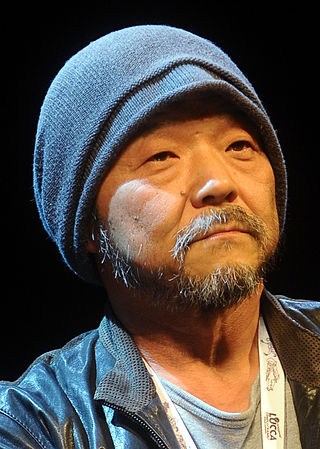
Mamoru Oshii is a Japanese filmmaker, television director and writer. Famous for his philosophy-oriented storytelling, Oshii has directed a number of acclaimed anime films, including Urusei Yatsura 2: Beautiful Dreamer (1984), Angel's Egg (1985), Patlabor 2: The Movie (1993), and Ghost in the Shell (1995). He also holds the distinction of having created the first ever OVA, Dallos (1983). As a writer, Oshii has worked as a screenwriter, and occasionally as a manga writer and novelist. His most notable works as a writer include the manga Kerberos Panzer Cop (1988–2000) and its feature film adaptation Jin-Roh: The Wolf Brigade (1999).
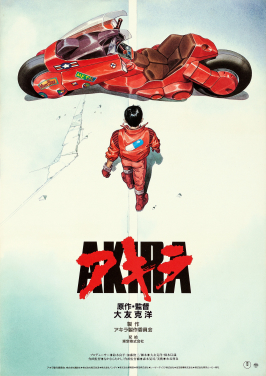
Akira is a 1988 Japanese animated cyberpunk action film directed by Katsuhiro Otomo, produced by Ryōhei Suzuki and Shunzō Katō, and written by Otomo and Izo Hashimoto, based on Otomo's 1982 manga of the same name. Set in a dystopian 2019, it tells the story of Shōtarō Kaneda, the leader of a biker gang whose childhood friend, Tetsuo Shima, acquires incredible telekinetic abilities after a motorcycle accident, eventually threatening an entire military complex amid chaos and rebellion in the sprawling futuristic metropolis of Neo-Tokyo.

Akira is a Japanese cyberpunk post-apocalyptic manga series written and illustrated by Katsuhiro Otomo. It was serialized biweekly in Kodansha's seinen manga magazine Young Magazine from December 20, 1982, to June 25, 1990, with its 120 chapters collected into six tankōbon volumes. It was initially published in the United States by Marvel Comics under its Epic imprint, becoming one of the first manga works to be translated in its entirety into English. It is currently published by Kodansha Comics in North America. Considered a watershed title for the medium, the manga is also famous for spawning the seminal 1988 cyberpunk anime film adaptation of the same name and the greater franchise.
Since the advent of the cyberpunk genre, a number of cyberpunk derivatives have become recognized in their own right as distinct subgenres in speculative fiction, especially in science fiction. Rather than necessarily sharing the digitally and mechanically focused setting of cyberpunk, these derivatives can display other futuristic, or even retrofuturistic, qualities that are drawn from or analogous to cyberpunk: a world built on one particular technology that is extrapolated to a highly sophisticated level, a gritty transreal urban style, or a particular approach to social themes.
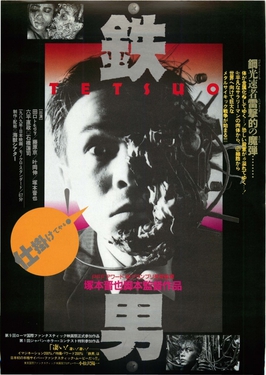
Tetsuo: The Iron Man is a 1989 Japanese science fiction horror film directed, written, produced, and edited by Shinya Tsukamoto. The film centers around an unnamed Japanese salaryman who wakes up to find pieces of metal sprouting from various parts of his body and becomes haunted by visions of metal-oriented sexual fantasies. As the man steadily becomes a hybrid of man and machine, he develops a connection with a victim from a hit-and-run accident, who is undergoing a similar transformation.

Science fiction is an important genre of modern Japanese literature that has strongly influenced aspects of contemporary Japanese pop culture, including anime, manga, video games, tokusatsu, and cinema.
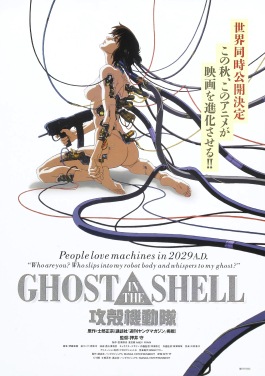
Ghost in the Shell is a 1995 adult animated neo-noir cyberpunk thriller film directed by Mamoru Oshii and adapted by frequent Oshii collaborator Kazunori Itō. The film is based on the manga of the same name by Masamune Shirow. It stars the voices of Atsuko Tanaka, Akio Ōtsuka, and Iemasa Kayumi. It is a Japanese-British international co-production, executive produced by Kodansha, Bandai Visual and Manga Entertainment, with animation provided by Production I.G, with the screenplay by Kazunori Itō.
Akira may refer to:
Death Powder is a 1986 low-budget science fiction/horror film with body horror elements, written and directed by Japanese poet/folk singer Shigeru Izumiya.
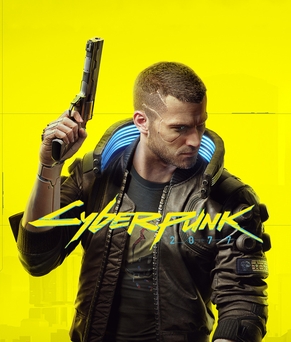
Cyberpunk 2077 is a 2020 action role-playing video game developed by CD Projekt Red and published by CD Projekt, based on video game designer Mike Pondsmith's tabletop game series. Set in a dystopian cyberpunk universe, the player assumes the role of "V", a mercenary in the fictional Californian city known as "Night City", where they deal with the fallout from a heist gone wrong that results in an experimental cybernetic "bio-chip" containing an engram of the legendary rock star and terrorist Johnny Silverhand threatening to slowly overwrite V's mind; as the story progresses V and Johnny must work together to find a way to be separated and save V's life.
Akira is a proposed American cyberpunk action film based on the Japanese manga of the same name by Katsuhiro Otomo, and was set to be the second film adaptation following the 1988 anime version. The film was written by Taika Waititi and Michael Golamco.

Akira is a Japanese cyberpunk media franchise based on Katsuhiro Otomo's seminal manga, Akira, published from 1982 to 1990. It was adapted into a 1988 anime film and two video games. A live-action feature film has also been in development since 2000, and a new anime television series by Otomo was also announced in 2019.

Cyberpunk: Edgerunners is a 2022 cyberpunk web anime series based on the video game Cyberpunk 2077 by CD Projekt Red. The series was animated by Japanese animation studio Trigger under the supervision of Polish CD Projekt and premiered on Netflix in September 2022. Set in the Cyberpunk universe created by Mike Pondsmith, the anime serves as a prequel to the game and takes place about a year before the events of Cyberpunk 2077.
References
- ↑ "Where to begin with Japanese cyberpunk". British Film Institute . 1 April 2019. Archived from the original on 30 August 2021. Retrieved 15 June 2019.
- ↑ Dazed (2020-05-08). "A guide to Japanese cyberpunk cinema with three of its visionary directors". Dazed. Archived from the original on 2020-11-26. Retrieved 2020-11-27.
- ↑ "Extreme Japanese Cyberpunk". Archived from the original on 2008-09-01. Retrieved 2008-09-01.
- 1 2 3 "What is cyberpunk?". Polygon . August 30, 2018. Archived from the original on October 14, 2018. Retrieved October 16, 2018.
- 1 2 3 4 "How 'Akira' Has Influenced All Your Favourite TV, Film and Music". VICE . September 21, 2016. Archived from the original on July 30, 2017. Retrieved October 16, 2018.
- 1 2 "'Akira' Is Frequently Cited as Influential. Why Is That?". Film School Rejects . April 3, 2017. Archived from the original on November 7, 2018. Retrieved October 16, 2018.
- ↑ Player, Mark. "Post-Human Nightmares: The World of Japanese Cyberpunk Cinema". Midnight Eye. Archived from the original on 2011-11-06. Retrieved 2011-10-31.
- 1 2 Player, Mark (13 May 2011). "Post-Human Nightmares – The World of Japanese Cyberpunk Cinema". Midnight Eye . Archived from the original on 12 May 2021. Retrieved 23 April 2020.
- ↑ "Katsuhiro Otomo | PAUL GRAVETT". www.paulgravett.com. Retrieved 2023-12-03.
- ↑ Brown, Todd. "Burst City / Electric Dragon 80000V Review". TwitchFilm. Archived from the original on 2009-07-10. Retrieved 2008-09-01.
- ↑ Tsukamoto, Shin'ya (2008-08-30), Denchû kozô no bôken (Comedy, Horror, Sci-Fi), Kei Fujiwara, Nobu Kanaoka, N. Senba, Tomorô Taguchi, Kaijyu Theater, archived from the original on 2021-01-24, retrieved 2021-01-03
- ↑ Tsukamoto, Shin'ya, Futsû saizu no kaijin (Short, Horror, Sci-Fi), Kei Fujiwara, Nobu Kanaoka, Tomorô Taguchi, Shin'ya Tsukamoto, Kaijyu Theater, archived from the original on 2019-06-02, retrieved 2021-01-03
- ↑ "JAPANESE CYBER-HORROR". fright.com. Archived from the original on 2011-07-20. Retrieved 2009-05-04.
- ↑ Ruh, Brian (2000), "Liberating Cels: Forms of the Female in Japanese Cyberpunk Animation Archived 2007-09-27 at the Wayback Machine ." AnimeResearch.com December 2000.
- ↑ Gibson, William (30 April 2001). "The Future Perfect". Time. Archived from the original on 24 February 2021. Retrieved 16 October 2018.
- ↑ Perper, T.; Cornog, M. (2009). "Psychoanalytic Cyberpunk Midsummer-Night's Dreamtime: Kon Satoshi's Paprika". Mechademia. 4: 326–329. doi: 10.1353/mec.0.0051 .
- 1 2 "200 Things That Rocked Our World: Bullet Time". Empire . EMAP (200): 136. February 2006.
- ↑ Proyas, Alex. "Dark City DC: Original Ending !?". Archived from the original on October 14, 2007. Retrieved 2008-08-29.
{{cite web}}: CS1 maint: bot: original URL status unknown (link). Mystery Clock Forum. Retrieved 2006-07-29. - ↑ Woerner, Meredith (2 February 2012). "Chronicle captures every teen's fantasy of fighting back, say film's creators". io9. Archived from the original on 26 February 2014. Retrieved 25 May 2012.
- ↑ "Rian Johnson Talks Working with Joseph Gordon-Levitt on LOOPER, Hollywood's Lack of Originality, Future Projects and More". Collider . 25 September 2012. Archived from the original on 19 June 2015. Retrieved 16 October 2018.
- ↑ Inside ‘Stranger Things’: The Duffer Bros. on How They Made the TV Hit of the Summer Archived 2017-05-06 at the Wayback Machine , The Daily Beast , August 7, 2016
- ↑ Hopper, Ben (February 20, 2001). "Great Games Snatcher". GameCritics.com. Archived from the original on 2011-10-21. Retrieved 2011-08-24.
- ↑ "Half-Life tiene varias referencias a Akira". MeriStation (in Spanish). Diario AS. August 29, 2018. Archived from the original on October 14, 2018. Retrieved October 16, 2018.
- ↑ "The most impressive PC mods ever made". TechRadar . June 14, 2018. Archived from the original on June 16, 2018. Retrieved October 16, 2018.
- ↑ "FEATURE: "Life is Strange" Interview and Hands-on Impressions". Crunchyroll . January 28, 2015. Archived from the original on October 14, 2018. Retrieved October 16, 2018.
- ↑ "THE CINEMA BEHIND STAR WARS: AKIRA". StarWars.com . Archived from the original on 2017-07-30. Retrieved 2021-02-26.
- ↑ "Lupe Fiasco's 'Tetsuo & Youth' Avoiding Politics – Rolling Stone". Rolling Stone. Archived from the original on 17 November 2014. Retrieved 2 December 2014.
- ↑ Francisco, Eric. "'Ready Player One' Anime Easter Eggs Include Gundam, Voltron and Much More". inverse.com. Archived from the original on 2018-08-22. Retrieved 2018-10-16.
- ↑ "Cyberpunk 2077 devs "will be significantly more open"". PCGamesN . June 12, 2018. Archived from the original on October 14, 2018. Retrieved October 16, 2018.
- ↑ "Here's Some Spiffy Unused Deus Ex: Mankind Divided Art, Inspired by Akira". Kotaku . July 17, 2017. Archived from the original on October 14, 2018. Retrieved October 16, 2018.
- ↑ Joel Silver, interviewed in "Making The Matrix" featurette on The Matrix DVD.
- 1 2 Rose, Steve (19 October 2009). "Hollywood is haunted by Ghost in the Shell". The Guardian . Archived from the original on 8 March 2013. Retrieved 26 July 2013.
- ↑ Schrodt, Paul (1 April 2017). "How the original 'Ghost in the Shell' changed sci-fi and the way we think about the future". Business Insider . Archived from the original on 26 August 2019. Retrieved 14 June 2019.
- ↑ "Hideo Kojima on the Philosophy Behind 'Ghost in the Shell'". Glixel . April 2017. Archived from the original on 2017-04-10. Retrieved April 10, 2017.
- ↑ "Ghost in the Shell (2017) – Blu-ray review". What Hi-Fi? Sound and Vision . August 7, 2017. Archived from the original on April 3, 2019. Retrieved October 16, 2018.
- ↑ Kushner, David (June 2000). "Ghost in the Machine". SPIN. 16 (6): 86. ISSN 0886-3032.
- ↑ Al-Shakarchi, Harry. "Interview with lead engineer Brent Pease". Bungie.org. Archived from the original on 2017-10-24. Retrieved 2013-12-22.
- ↑ Al-Shakarchi, Harry. "Interview with concept artist Alex Okita". Bungie.org. Archived from the original on 2016-03-14. Retrieved 2019-04-03.
- ↑ "Cyberpunk 2077 Devs Looked at Blade Runner and Ghost in the Shell for Inspiration". GamingBolt. 13 January 2019. Archived from the original on 27 February 2019. Retrieved 14 June 2019.
- ↑ Conditt, Jessica (1 August 2012). "CD Projekt Red's 'Cyberpunk' inspired by System Shock, Blade Runner [Update]". Engadget . Archived from the original on 14 October 2018.
- ↑ "Megazone 23 - Retroactive Influence". A.D. Vision. Archived from the original on 2005-02-04. Retrieved 2010-03-20.
- ↑ Pellitteri, Marco; Bouissou, Jean-Marie; Fratta, Gianluca Di; Martorella, Cristiano; Suvilay, Bounthavy (2010). The Dragon and the Dazzle: Models, Strategies, and Identities of Japanese Imagination : a European Perspective. Tunué. p. 607. ISBN 9788889613894.
- ↑ "Live-Action "Alita: Battle Angel" Finally Shows Its Hand". Crunchyroll . December 8, 2017. Archived from the original on January 16, 2020. Retrieved October 16, 2018.
- ↑ "Interview - André Lima Araújo Talks Man: Plus". Flickering Myth. January 24, 2016. Archived from the original on September 3, 2020. Retrieved October 16, 2018.